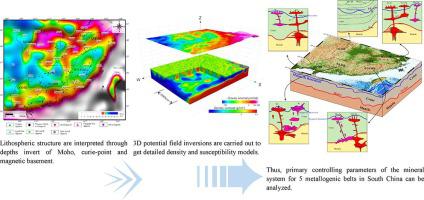Journal of Asian Earth Sciences ( IF 3 ) Pub Date : 2021-09-13 , DOI: 10.1016/j.jseaes.2021.104938 Jiayong Yan 1, 2, 3 , Qingtian Lü 1, 2 , Fan Luo 1, 2, 3 , Shaobo Cheng 1, 2 , Kun Zhang 1, 2 , Yongqian Zhang 1, 2 , Yao Xu 1, 2 , Chong Zhang 1, 2 , Zhendong Liu 1, 2 , Shuai Ruan 1, 2 , Xu Wang 1, 2

|
South China is characterized by enormous volumes of igneous rocks generated by multiple stages of magmatism. Five large-scale metallogenic belts with many world-class deposits have been discovered, demonstrating great potential for prospecting new resources. To restrict the South China metallogenic cognition the main problems include the types and metal associations of the deposits, factors controlling the distribution of the different types of metallogenic belts, and targets for new deposits. To find possible and feasible solutions to solve these problems. It is necessary to consider the metallogenic factors from the concept of mineral systems. This study first converted the satellite gravity into Bouguer gravity under spherical coordinates. Then the reduction-to-the pole (RTP) magnetic anomalies were obtained using a moving window with different geomagnetic parameters. The vertical lithospheric interfaces and main faults were inverted and interpreted according to these gravity and magnetic data. Based on the results obtained, we have discussed the possible sources and pathways of the five metallogenic belts in South China. Meanwhile, it identified the 3D spatial distribution of intrusions qualitatively by inverted susceptibility and density model, and predicted the potential sites for Cu, Fe, Au, W, and Sn deposits.
中文翻译:

华南岩石圈结构的重磁研究及其对主要成矿带岩体和矿物系统分布的影响
华南地区的特点是大量岩浆作用产生的火成岩。已发现5条大型成矿带,拥有众多世界级矿床,具有巨大的新资源找矿潜力。制约华南成矿认识的主要问题包括矿床的类型和金属组合、控制不同类型成矿带分布的因素、新矿床的目标等。寻找可能可行的解决方案来解决这些问题。有必要从矿物系统的概念考虑成矿因素。本研究首先将卫星重力转化为球坐标下的布格重力。然后使用具有不同地磁参数的移动窗口获得归零到极点(RTP)磁异常。根据这些重磁数据对垂直岩石圈界面和主要断层进行反演和解释。在此基础上,我们讨论了华南五个成矿带的可能来源和路径。同时,通过反演磁化率和密度模型定性识别侵入体的3D空间分布,并预测Cu、Fe、Au、W和Sn矿床的潜在位置。我们讨论了华南五个成矿带的可能来源和路径。同时,通过反演磁化率和密度模型定性识别侵入体的3D空间分布,并预测Cu、Fe、Au、W和Sn矿床的潜在位置。我们讨论了华南五个成矿带的可能来源和路径。同时,通过反演磁化率和密度模型定性识别侵入体的3D空间分布,并预测Cu、Fe、Au、W和Sn矿床的潜在位置。



























 京公网安备 11010802027423号
京公网安备 11010802027423号